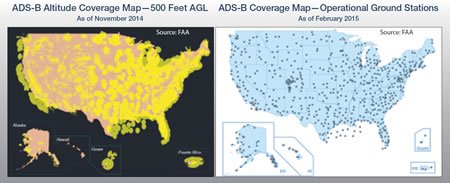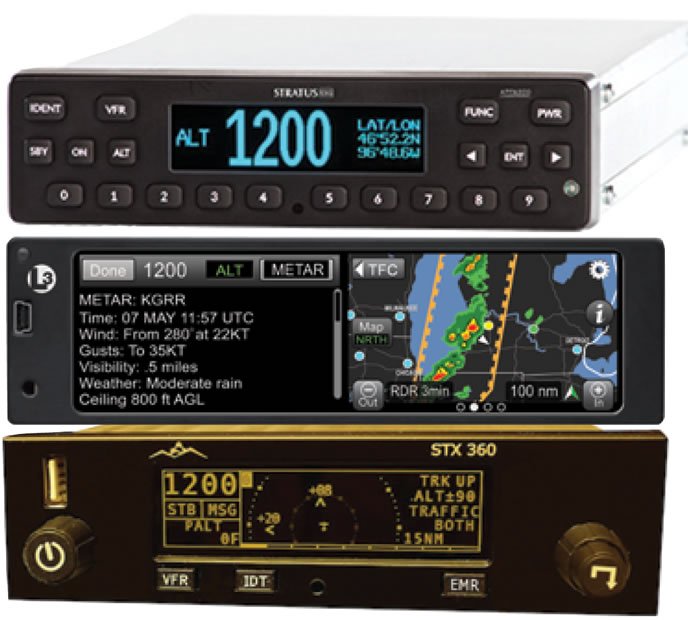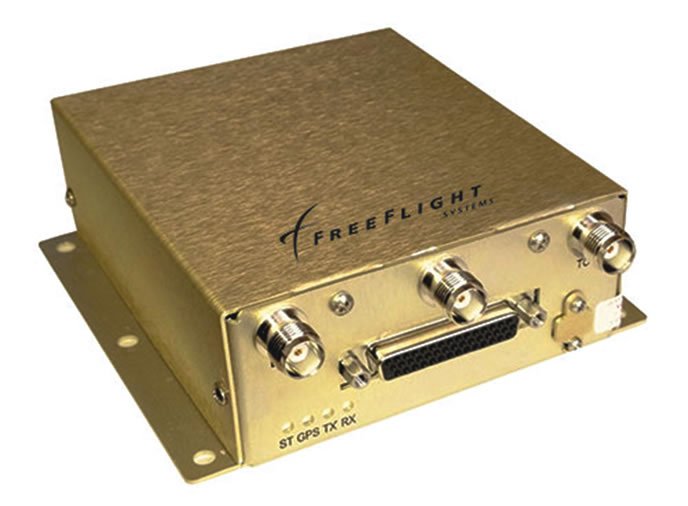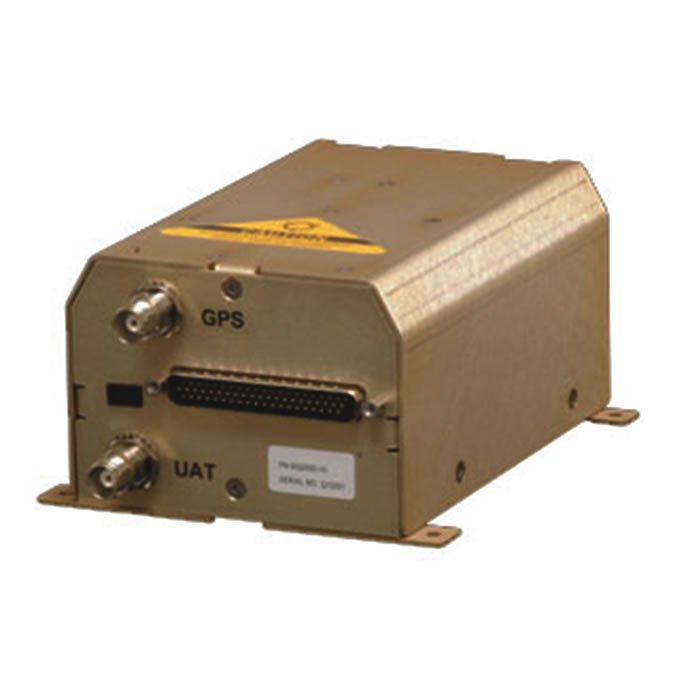Unless you’ve been living under a rock, you’ve probably heard of ADS-B, or Automatic Dependent Surveillance-Broadcast. As of January 1, 2020, you’ll need this equipment to routinely fly in U.S. airspace where the FARs now require a working Mode C transponder. The FAA rule mandating ADS-B in 2020 went into effect in 2010, so there’s little argument that operators haven’t had enough warning about it, and it’s not likely the FAA will change the deadline. There are two flavors of ADS-B, the “in” and “out” kinds. For now, only ADS-B Out is required in 2020; ADS-B In is optional. Both flavors are operational today, as the two coverage maps below demonstrate.
You or a pilot you know may already be flying with ADS-B In, perhaps using a portable receiver, but that’s a relatively easy and inexpensive option, at least as far as aviation is concerned. Until recently, there weren’t many low-cost options for ADS-B Out. That’s changing, however, and a new crop of products from various manufacturers may be as good and inexpensively priced as we’re going to see before the deadline. In the four-plus years before the deadline, it’s highly likely other products will be developed and brought to market. But as the deadline looms closer, demand will rise, as may prices. Is it time to make what may be a 20-year, $10,000 decision, and commit to a specific ADS-B solution?

Two Of Everything
For the typical aircraft owner, the decision of when and how to upgrade an in-service aircraft with ADS-B can be complicated. It’s a calculus involving how the aircraft is used, the avionics it already has and whether that equipment supports ADS-B Out. You also need to decide if you want to obtain ADS-B In, and how you want to display it.
As its name implies, ADS-B In is the FAA’s free, over-the-air Traffic Information System-Broadcast (TIS-B) and Flight Information System-Broadcast (FIS-B) data. When you connect an appropriate receiver like Appareo’s Stratus II or Garmin’s GDL-39 to a suitable tablet-based electronic flight bag (EFB) app—or channel that data to compatible panel-mounted glass—it will display TIS-B traffic and FIS-B Nexrad weather radar, plus other flight information, like Metars and TFRs. Fairly straightforward so far, right?
Just as there are two kinds of ADS-B, In and Out, there are two kind of ADS-B Out, based on the radio frequencies their transceivers use. The so-called 978 UAT flavor of ADS-B Out operates on 978 MHz (duh…) and only is approved for use in U.S. airspace below 18,000 feet (FL180). The 1090 ES (extended squitter, a transponder term) flavor of ADS-B Out works on 1090 MHz and is approved at all altitudes. Other nations implementing ADS-B are deploying 1090 ES alone. The trick? Only 978 UAT supports FIS-B; If all you have is the 1090 ES flavor of ADS-B, you won’t be able to obtain FIS-B except with a portable receiver.
Finally, ADS-B Out requires an accurate position source. While the requirements do not specify WAAS GPS as the position source, it’s the only cost-effective and readily available technology presently complying with ADS-B specifications. If you have a TSO’d and certified (e.g., panel-mounted) WAAS GPS-based navigator, you may be able to use it as part of your ADS-B solution with a Mode S transponder capable of meeting the 1090 ES standard. To our knowledge, Garmin and Avidyne are the only manufacturers offering a TSO’d WAAS GPS-based navigator. Both offer Mode S transponders capable of being upgraded to 1090 ES and accepting WAAS GPS data for an approved ADS-B Out solution. Your WAAS GPS also may be used as a position source for a 978 UAT solution.

978 UAT Solutions
Since ADS-B’s 978 UAT (universal access transceiver) is approved only below FL180 and since it’s the only way to obtain FIS-B’s Nexrad, weather, TFR and other data, it’s a logical choice for many personal aircraft that’ll never see FL180. It does come with some drawbacks, however.
Perhaps the most glaring drawback of the 978 UAT flavor of ADS-B Out is the need for a working Mode C transponder even if you have ADS-B Out. That’s right—an approved ADS-B Out solution implemented using 978 UAT technology alone still must carry a Mode C transponder. That’s basically because transponder technology currently is required to work with traffic-detection systems aboard other aircraft, like TCAS.
Further, the data transmitted by the ADS-B Out box and the Mode C transponder have to agree. To ensure an ADS-B Out solution implemented with 978 UAT equipment sends the correct squawk code and altitude to ATC, many aircraft may need a separate control panel to link their new ADS-B Out hardware with their Mode C transponder.
Will a Mode C transponder be required indefinitely? Perhaps. The FAA says it “is considering additional changes in the national airspace system, such as for TCAS. These changes, may at some future date, reduce or eliminate the need for transponder equipage.” Manufacturers offering 978 UAT-based ADS-B Out solutions may require a separate control panel into which squawk codes can be entered.
1090 ES Solutions
Just because 1090 ES is required at and above FL180 doesn’t mean you can’t use it below 18,000 feet—you can. (Aircraft in the flight levels still have to use the airspace below FL180 twice each flight, of course.) You just can’t receive FIS-B weather information with a box implementing 1090 ES alone.
Although they probably exist, especially for heavy iron, we’re not aware of any 1090 ES ADS-B Out solutions that aren’t packaged in the same form factor as a basic panel-mounted Mode C transponder like a BendixKing KT76A. Since ADS-B is a surveillance technology, versus one involving the communications or navigation functions of other equipment we carry, it makes sense to us to put ADS-B Out’s functionality into a transponder-size box mounted in the panel where we can manipulate its controls and read its display. Since 978 UAT isn’t being implemented anywhere except below FL180 in the U.S., international operations may not be allowed if all you have aboard is a 978 UAT-based ADS-B solution.

A problem with going only with a 1090 ES box is there’s no way to receive FIS-B with that technology. An additional receiver—perhaps a portable—may be needed for FIS-B. There’s also the issue of whether TIS-B data generated by 978 UAT-equipped aircraft will be displayed on a 1090 ES-only system. This can be hardware-dependent and is something to verify before writing a check. The converse may also be true: 1090 ES TIS-B data may not be available on a 978 UAT-only system. Leave it to the FAA to come up with two different ADS-B technologies and two different services that aren’t cross-platform compatible.

What To Do?
To us, the most interesting ADS-B products are one-box solutions, providing both compliance and TIS-B/FIS-B, and eliminating the need to carry a Mode C transponder. That means going 1090 ES but with an integral 978 UAT receiver. It should fit into the panel where we can see and control it directly, and its ADS-B In capabilities should work with any EFB app we choose, on any tablet computer and/or with our panel-mounted displays. It also should have built-in WAAS GPS, requiring only an appropriate antenna. And it should cost only one or two AMUs (aviation maintenance units, currently valued at $1000 apiece). The 1090 ES solutions pictured on the opposite page from Appareo, L-3 and Sandia come close to our ideal—L-3’s perhaps the closest—but they all fail the “AMU test.”
Is it time to bite the ADS-B bullet? Perhaps. It depends on whether you think feature sets and prices will improve if you wait. Historically, they have, and eventually the price/performance curves meet. That time may be here.




